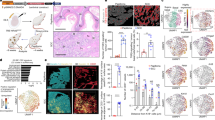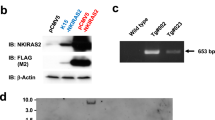Abstract
Ras genes are commonly mutated in human cancers of the skin and other tissues. Oncogenic Ras signals through multiple effector pathways, including the Erk1/2 mitogen-activated protein kinase (MAPK), phosphatidylinositol-3 kinase (PI3K) and the Ral guanine nucleotide exchange factor (RalGEF) cascades. In epidermis, the activation of oncogenic Ras induces hyperplasia and inhibits differentiation, features characteristic of squamous cell carcinoma. The downstream effector pathways required for oncogenic Ras effects in epidermis, however, are undefined. In this study, we investigated the direct contribution of Mek1 and Mek2 MAPKKs to oncogenic Ras signaling. The response of murine epidermis to conditionally active oncogenic Ras was unimpaired by deletion of either Mek1 or Mek2 MAPKKs individually. In contrast, Ras effects were entirely abolished by combined deletion of all Mek1/2 alleles, whereas epidermis retaining only one allele of either Mek1 or Mek2 showed intermediate responsiveness. Thus, the effects of oncogenic Ras on proliferation and differentiation in skin show a gene dosage-dependent requirement for the Erk1/2 MAPK cascade at the level of Mek1/2 MAPKKs.
This is a preview of subscription content, access via your institution
Access options
Subscribe to this journal
Receive 50 print issues and online access
$259.00 per year
only $5.18 per issue
Buy this article
- Purchase on Springer Link
- Instant access to full article PDF
Prices may be subject to local taxes which are calculated during checkout





Similar content being viewed by others
References
Aoki Y, Niihori T, Narumi Y, Kure S, Matsubara Y . (2008). The RAS/MAPK syndromes: novel roles of the RAS pathway in human genetic disorders. Hum Mutat 29: 992–1006.
Bailleul B, Surani MA, White S, Barton SC, Brown K, Blessing M et al. (1990). Skin hyperkeratosis and papilloma formation in transgenic mice expressing a ras oncogene from a suprabasal keratin promoter. Cell 62: 697–708.
Belanger LF, Roy S, Tremblay M, Brott B, Steff AM, Mourad W et al. (2003). Mek2 is dispensable for mouse growth and development. Mol Cell Biol 23: 4778–4787.
Bissonauth V, Roy S, Gravel M, Guillemette S, Charron J . (2006). Requirement for Mapk2k1 (Mek1) in extraembryonic ectoderm during placentogenesis. Development 133: 3429–3440.
Brown K, Strathdee D, Bryson S, Lambie W, Balmain A . (1998). The malignant capacity of skin tumours induced by expression of a mutant H-ras transgene depends on the cell type targeted. Curr Biol 8: 516–524.
Castro AF, Rebhun JF, Quilliam LA . (2005). Measuring Ras-family GTP levels in vivo—running hot and cold. Methods 37: 190–196.
Chambard JC, Lefloch R, Pouyssegur J, Lenormand P . (2007). ERK implication in cell cycle regulation. Biochim Biophys Acta 1773: 1299–1310.
Dajee M, Lazarov M, Zhang JY, Cai T, Green CL, Russell AJ et al. (2003). NF-kappaB blockade and oncogenic Ras trigger invasive human epidermal neoplasia. Nature 421: 639–643.
Dajee M, Tarutani M, Deng H, Cai T, Khavari PA . (2002). Epidermal Ras blockade demonstrates spatially localized Ras promotion of proliferation and inhibition of differentiation. Oncogene 21: 1527–1538.
Denley A, Gymnopoulos M, Hart JR, Jiang H, Zhao L, Vogt PK . (2008a). Biochemical and biological characterization of tumor-associated mutations of p110alpha. Methods Enzymol 438: 291–305.
Denley A, Kang S, Karst U, Vogt PK . (2008b). Oncogenic signaling of class I PI3K isoforms. Oncogene 27: 2561–2574.
Dhillon AS, Hagan S, Rath O, Kolch W . (2007). MAP kinase signalling pathways in cancer. Oncogene 26: 3279–3290.
Editorials (2007). Toxic alert. Nature 449: 378.
Estep AL, Palmer C, McCormick F, Rauen KA . (2007). Mutation analysis of BRAF, MEK1 and MEK2 in 15 ovarian cancer cell lines: implications for therapy. PLoS ONE 2: e1279.
Fuchs E, Horsley V . (2008). More than one way to skin. Genes Dev 22: 976–985.
Giroux S, Tremblay M, Bernard D, Cardin-Girard JF, Aubry S, Larouche L et al. (1999). Embryonic death of Mek1-deficient mice reveals a role for this kinase in angiogenesis in the labyrinthine region of the placenta. Curr Biol 9: 369–372.
Gonzalez-Garcia A, Pritchard CA, Paterson HF, Mavria G, Stamp G, Marshall CJ . (2005). RalGDS is required for tumor formation in a model of skin carcinogenesis. Cancer Cell 7: 219–226.
Greenhalgh DA, Rothnagel JA, Quintanilla MI, Orengo CC, Gagne TA, Bundman DS et al. (1993). Induction of epidermal hyperplasia, hyperkeratosis, and papillomas in transgenic mice by a targeted v-Ha-ras oncogene. Mol Carcinog 7: 99–110.
Gupta S, Ramjaun AR, Haiko P, Wang Y, Warne PH, Nicke B et al. (2007). Binding of ras to phosphoinositide 3-kinase p110alpha is required for ras-driven tumorigenesis in mice. Cell 129: 957–968.
Hoshino R, Chatani Y, Yamori T, Tsuruo T, Oka H, Yoshida O et al. (1999). Constitutive activation of the 41-/43-kDa mitogen-activated protein kinase signaling pathway in human tumors. Oncogene 18: 813–822.
Kratz CP, Niemeyer CM, Zenker M . (2007). An unexpected new role of mutant Ras: perturbation of human embryonic development. J Mol Med 85: 227–235.
Li M, Indra AK, Warot X, Brocard J, Messaddeq N, Kato S et al. (2000). Skin abnormalities generated by temporally controlled RXRalpha mutations in mouse epidermis. Nature 407: 633–636.
Marks JL, Gong Y, Chitale D, Golas B, McLellan MD, Kasai Y et al. (2008). Novel MEK1 mutation identified by mutational analysis of epidermal growth factor receptor signaling pathway genes in lung adenocarcinoma. Cancer Res 68: 5524–5528.
McCubrey JA, Milella M, Tafuri A, Martelli AM, Lunghi P, Bonati A et al. (2008). Targeting the Raf/MEK/ERK pathway with small-molecule inhibitors. Curr Opin Investig Drugs 9: 614–630.
Murayama K, Kimura T, Tarutani M, Tomooka M, Hayashi R, Okabe M et al. (2007). Akt activation induces epidermal hyperplasia and proliferation of epidermal progenitors. Oncogene 26: 4882–4888.
Naiche LA, Papaioannou VE . (2007). Cre activity causes widespread apoptosis and lethal anemia during embryonic development. Genesis 45: 768–775.
Oh WJ, Rishi V, Pelech S, Vinson C . (2007). Histological and proteomic analysis of reversible H-RasV12G expression in transgenic mouse skin. Carcinogenesis 28: 2244–2252.
Pierceall WE, Goldberg LH, Tainsky MA, Mukhopadhyay T, Ananthaswamy HN . (1991). Ras gene mutation and amplification in human nonmelanoma skin cancers. Mol Carcinog 4: 196–202.
Schmidt-Supprian M, Rajewsky K . (2007). Vagaries of conditional gene targeting. Nat Immunol 8: 665–668.
Scholl FA, Dumesic PA, Barragan DI, Harada K, Bissonauth V, Charron J et al. (2007). Mek1/2 MAPK kinases are essential for Mammalian development, homeostasis, and Raf-induced hyperplasia. Dev Cell 12: 615–629.
Scholl FA, Dumesic PA, Khavari PA . (2004). Mek1 alters epidermal growth and differentiation. Cancer Res 64: 6035–6040.
Shaul YD, Seger R . (2007). The MEK/ERK cascade: from signaling specificity to diverse functions. Biochim Biophys Acta 1773: 1213–1226.
Sturgill TW . (2008). MAP kinase: it's been longer than fifteen minutes. Biochem Biophys Res Commun 371: 1–4.
Sun B, Gao Y, Deng L, Li G, Cheng F, Wang X . (2008). The level of oncogene H-Ras correlates with tumorigenicity and malignancy. Cell Cycle 7: 934–939.
Tarutani M, Cai T, Dajee M, Khavari PA . (2003). Inducible activation of Ras and Raf in adult epidermis. Cancer Res 63: 319–323.
Vasioukhin V, Degenstein L, Wise B, Fuchs E . (1999). The magical touch: genome targeting in epidermal stem cells induced by tamoxifen application to mouse skin. Proc Natl Acad Sci USA 96: 8551–8556.
Wallace EM, Lyssikatos JP, Yeh T, Winkler JD, Koch K . (2005). Progress towards therapeutic small molecule MEK inhibitors for use in cancer therapy. Curr Top Med Chem 5: 215–229.
Wolthuis RM, Zwartkruis F, Moen TC, Bos JL . (1998). Ras-dependent activation of the small GTPase Ral. Curr Biol 8: 471–474.
Yoon S, Seger R . (2006). The extracellular signal-regulated kinase: multiple substrates regulate diverse cellular functions. Growth Factors 24: 21–44.
Acknowledgements
We thank A Truong and K Jameson for critical reading of the manuscript, E Fuchs for K14-Cre mice, P Chambon for K14-CreER mice, C Enrile for histological work, H Bernstein, P Bernstein and N Griffiths for support. This study was supported by the US VA Office of Research and Development and by AR49737 from NIAMS/NIH to PAK, the Swiss cancer foundation Grant BIL SKL-01236-02-2002 to FAS and MOP-67208 from CIHR to JC.
Author information
Authors and Affiliations
Corresponding author
Additional information
Supplementary Information accompanies the paper on the Oncogene website (http://www.nature.com/onc)
Rights and permissions
About this article
Cite this article
Scholl, F., Dumesic, P., Barragan, D. et al. Mek1/2 gene dosage determines tissue response to oncogenic Ras signaling in the skin. Oncogene 28, 1485–1495 (2009). https://doi.org/10.1038/onc.2008.459
Received:
Revised:
Accepted:
Published:
Issue Date:
DOI: https://doi.org/10.1038/onc.2008.459
Keywords
This article is cited by
-
Essential, non-redundant roles of B-Raf and Raf-1 in Ras-driven skin tumorigenesis
Oncogene (2013)
-
Ras and Raf pathways in epidermis development and carcinogenesis
British Journal of Cancer (2011)
-
From basic research to clinical development of MEK1/2 inhibitors for cancer therapy
Journal of Hematology & Oncology (2010)



